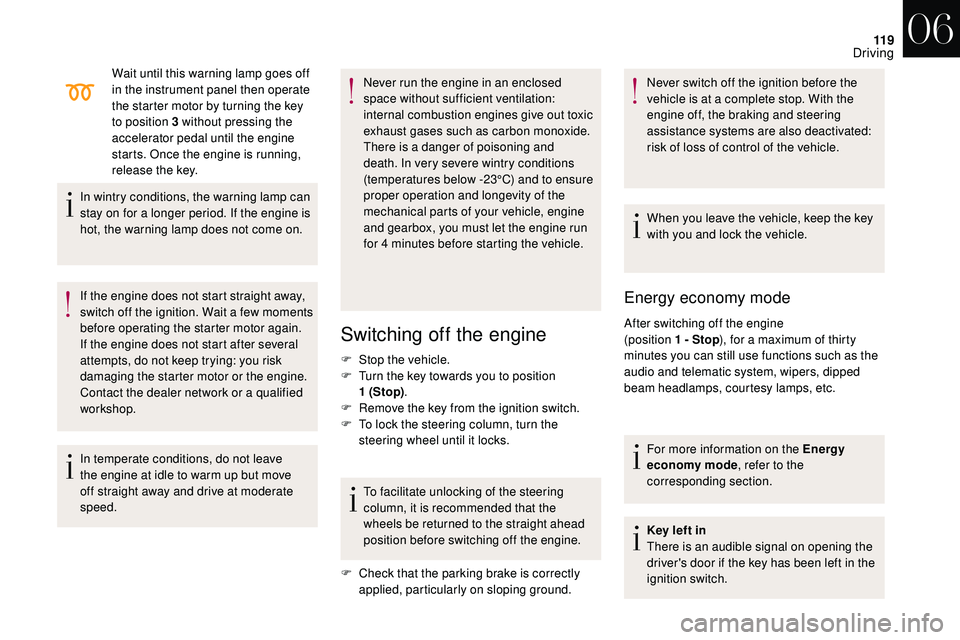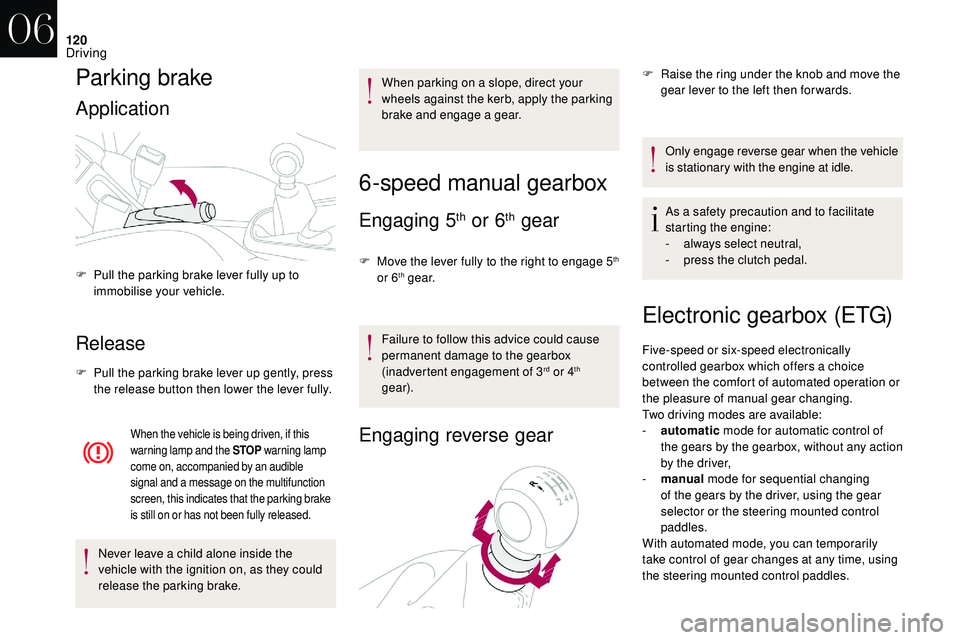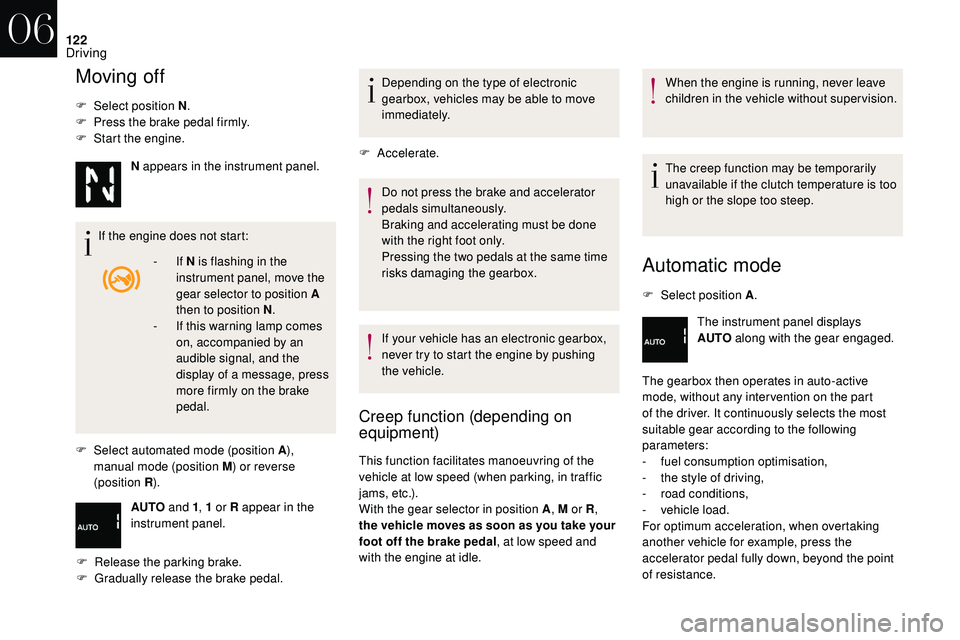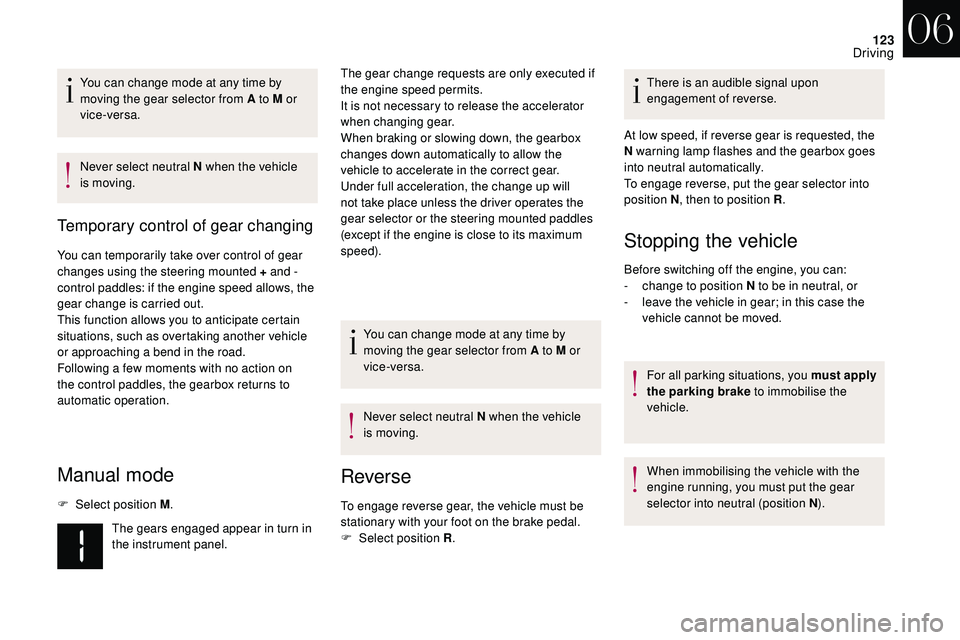CITROEN DS3 2018 Handbook (in English)
Manufacturer: CITROEN, Model Year: 2018, Model line: DS3, Model: CITROEN DS3 2018Pages: 248, PDF Size: 8.79 MB
Page 121 of 248

11 9
Wait until this warning lamp goes off
in the instrument panel then operate
the starter motor by turning the key
to position 3 without pressing the
accelerator pedal until the engine
starts. Once the engine is running,
release the key.
In wintry conditions, the warning lamp can
stay on for a
longer period. If the engine is
hot, the warning lamp does not come on.
If the engine does not start straight away,
switch off the ignition. Wait a
few moments
before operating the starter motor again.
If the engine does not start after several
attempts, do not keep trying: you risk
damaging the starter motor or the engine.
Contact the dealer network or a
qualified
workshop.
In temperate conditions, do not leave
the engine at idle to warm up but move
off straight away and drive at moderate
speed. Never run the engine in an enclosed
space without sufficient ventilation:
internal combustion engines give out toxic
exhaust gases such as carbon monoxide.
There is a danger of poisoning and
death. In very severe wintry conditions
(temperatures below -23°C) and to ensure
proper operation and longevity of the
mechanical parts of your vehicle, engine
and gearbox, you must let the engine run
for 4
minutes before starting the vehicle.
Switching off the engine
F Stop the vehicle.
F T urn the key towards you to position
1
(Stop) .
F
R
emove the key from the ignition switch.
F
T
o lock the steering column, turn the
steering wheel until it locks.
To facilitate unlocking of the steering
column, it is recommended that the
wheels be returned to the straight ahead
position before switching off the engine.
F
C
heck that the parking brake is correctly
applied, particularly on sloping ground. Never switch off the ignition before the
vehicle is at a
complete stop. With the
engine off, the braking and steering
assistance systems are also deactivated:
risk of loss of control of the vehicle.
When you leave the vehicle, keep the key
with you and lock the vehicle.
Energy economy mode
After switching off the engine
(position 1 - Stop), for a
maximum of thirty
minutes you can still use functions such as the
audio and telematic system, wipers, dipped
beam headlamps, courtesy lamps, etc.
For more information on the Energy
economy mode , refer to the
corresponding section.
Key left in
There is an audible signal on opening the
driver's door if the key has been left in the
ignition switch.
06
Driving
Page 122 of 248

120
Parking brake
Application
Release
F Pull the parking brake lever up gently, press the release button then lower the lever fully.
When the vehicle is being driven, if this
warning lamp and the STOP warning lamp
come on, accompanied by an audible
signal and a
message on the multifunction
screen, this indicates that the parking brake
is still on or has not been fully released.
Never leave a child alone inside the
v ehicle with the ignition on, as they could
release the parking brake. When parking on a
slope, direct your
wheels against the kerb, apply the parking
brake and engage a
gear.
6-speed manual gearbox
Engaging 5th or 6th gear
F Move the lever fully to the right to engage 5th
or 6th g e a r.
Failure to follow this advice could cause
permanent damage to the gearbox
(inadvertent engagement of 3
rd or 4th
gear).
Engaging reverse gear
F Raise the ring under the knob and move the gear lever to the left then for wards.
Only engage reverse gear when the vehicle
is stationary with the engine at idle.
As a
safety precaution and to facilitate
starting the engine:
-
a
lways select neutral,
-
p
ress the clutch pedal.
F
P
ull the parking brake lever fully up to
immobilise your vehicle.
Electronic gearbox (ETG)
Five-speed or six-speed electronically
controlled gearbox which offers a choice
between the comfort of automated operation or
the pleasure of manual gear changing.
Two driving modes are available:
-
a
utomatic mode for automatic control of
the gears by the gearbox, without any action
by the driver,
-
man
ual mode for sequential changing
of the gears by the driver, using the gear
selector or the steering mounted control
paddles.
With automated mode, you can temporarily
take control of gear changes at any time, using
the steering mounted control paddles.
06
Driving
Page 123 of 248

121
Gear selector positions
R.Reverse.
F
W ith your foot on the brake, move
the selector for wards to select this
position.
N. Neutral.
F
W
ith your foot on the brake, select this
position to start the engine.
A. Automatic mode.
F
M
ove the selector backwards to select
this mode. M +/-.
Manual mode with sequential gear
changing.
F
M
ove the selector backwards,
then to the left to select this
mode.
F
P
ush forwards to change up
through the gears.
F
P
ull backwards to change down
through the gears.
Steering mounted controls
+. Control located on the right of the steering
wheel to change up through the gears.
F
P
ress the back of the " +" steering mounted
paddle to change up a
gear.
-. Control located on the left of the steering
wheel to change down through the gears.
F
P
ress the back of the " -" steering mounted
paddle to change down a
gear.The steering mounted control paddles
cannot be used to select neutral or to
select or come out of reverse, nor to
change a
driving mode.
Display in the instrument panel
N.
Neutral.
R. Reverse.
1
2 3 4 5/6.Gears in manual mode.
AUTO. It comes on when the automatic
mode is selected. It switches off
on changing to manual mode.
06
Driving
Page 124 of 248

122
Moving off
F Select position N.
F P ress the brake pedal firmly.
F
S
tart the engine.
If the engine does not start:
F
Sel
ect automated mode (position A ),
manual mode (position M ) or reverse
(position R ).
F
R
elease the parking brake.
F
G
radually release the brake pedal. Depending on the type of electronic
gearbox, vehicles may be able to move
immediately.
F
Accelerate.Do not press the brake and accelerator
pedals simultaneously.
Braking and accelerating must be done
with the right foot only.
Pressing the two pedals at the same time
risks damaging the gearbox.
If your vehicle has an electronic gearbox,
never try to start the engine by pushing
the vehicle.
Creep function (depending on
equipment)
This function facilitates manoeuvring of the
vehicle at low speed (when parking, in traffic
jams, etc.).
With the gear selector in position A , M or R,
the vehicle moves as soon as you take your
foot off the brake pedal , at low speed and
with the engine at idle.
Automatic mode
F Select position A .
The instrument panel displays
AUTO along with the gear engaged.
The gearbox then operates in auto-active
mode, without any inter vention on the part
of the driver. It continuously selects the most
suitable gear according to the following
parameters:
-
f
uel consumption optimisation,
-
t
he style of driving,
-
r
oad conditions,
-
v
ehicle load.
For optimum acceleration, when overtaking
another vehicle for example, press the
accelerator pedal fully down, beyond the point
of resistance.
N appears in the instrument panel.
-
If
N is flashing in the
instrument panel, move the
gear selector to position A
then to position N .
-
I
f this warning lamp comes
on, accompanied by an
audible signal, and the
display of a
message, press
more firmly on the brake
pedal.
AUTO and 1, 1
or R appear in the
instrument panel. When the engine is running, never leave
children in the vehicle without super vision.
The creep function may be temporarily
unavailable if the clutch temperature is too
high or the slope too steep.
06
Driving
Page 125 of 248

123
You can change mode at any time by
moving the gear selector from A to M or
vice-versa.
Never select neutral N when the vehicle
is moving.
Temporary control of gear changing
You can temporarily take over control of gear
changes using the steering mounted + and -
control paddles: if the engine speed allows, the
gear change is carried out.
This function allows you to anticipate certain
situations, such as overtaking another vehicle
or approaching a bend in the road.
Following a
few moments with no action on
the control paddles, the gearbox returns to
automatic operation.
Manual mode
F Select position M .
Reverse
To engage reverse gear, the vehicle must be
stationary with your foot on the brake pedal.
F
Sel
ect position R .
Stopping the vehicle
Before switching off the engine, you can:
-
c hange to position N to be in neutral, or
-
l
eave the vehicle in gear; in this case the
vehicle cannot be moved.
For all parking situations, you must apply
the parking brake to immobilise the
vehicle.
The gears engaged appear in turn in
the instrument panel. The gear change requests are only executed if
the engine speed permits.
It is not necessary to release the accelerator
when changing gear.
When braking or slowing down, the gearbox
changes down automatically to allow the
vehicle to accelerate in the correct gear.
Under full acceleration, the change up will
not take place unless the driver operates the
gear selector or the steering mounted paddles
(except if the engine is close to its maximum
speed).
You can change mode at any time by
moving the gear selector from A to M or
vice-versa.
Never select neutral N when the vehicle
is moving. There is an audible signal upon
engagement of reverse.
At low speed, if reverse gear is requested, the
N warning lamp flashes and the gearbox goes
into neutral automatically.
To engage reverse, put the gear selector into
position N , then to position R .
When immobilising the vehicle with the
engine running, you must put the gear
selector into neutral (position N ).
06
Driving
Page 126 of 248

124
Reinitialisation (5-speed
electronic gearbox)
Following disconnection of the battery, you
have to reinitialise the gearbox.
F
S
witch on the ignition. In exceptional circumstances, it may
be necessary to reinitialise the gearbox
automatically: in such a
case the vehicle
will not start and no gear change will
happen.
Operating fault
With the ignition on, if this warning
lamp comes on and AUTO flashes,
accompanied by an audible signal
and a
message in the multifunction
screen, this indicates a
gearbox
fault.
Have it checked by an authorised
dealer or by a
qualified workshop.
AUTO
and - - appear in the
instrument panel.
F
Sel
ect position N .
F
P
ress the brake pedal.
F
W
ait for approximately 30
seconds until N or
a
gear appears in the instrument panel.
F
M
ove the gear selector to position A , then to
position N .
F
W
ith your foot still on the brake pedal, start
the engine.
The gearbox is operational again. AUTO
and - - appear in the
instrument panel.
Follow the procedure described above.
Automatic gearbox
Four-speed automatic gearbox which offers
a choice between the comfort of fully automatic
operation, enhanced by sport and snow
programmes, or manual gear changing. Two driving modes are available:
-
a
utomatic
operation with electronic
management of the gears by the gearbox,
with a sport
programme for a more dynamic
driving style and a snow
programme to
make driving easier when grip is poor,
-
man
ual
operation for sequential changing
of the gears by the driver.
Gear box deck
1 Gear selector knob.
2 "S " (spor t) button.
3 "T " (snow) button.
Before doing anything under the bonnet,
ensure that the gear selector is in neutral
(position N
) and that the parking brake is
applied.
06
Driving
Page 127 of 248

125
Gear selector positions
P.Park.
-
V ehicle immobilised, parking brake on
or of f.
-
S
tarting the engine.
R. Reverse.
-
R
eversing manoeuvres, vehicle
stationary, engine at idle.
N. Neutral.
-
V
ehicle immobilised, parking brake
on.
-
S
tarting the engine.
D. Automatic operation.
M +/-. Manual operation with sequential
changing of the four gears.
F
P
ush forwards to change up
through the gears.
or
F
P
ull backwards to change down
through the gears.
Displays in the instrument panel
When you move the drive selector through
the selector gate to select a position, the
corresponding indicator is displayed in the
instrument panel.
P. Park.
R. Reverse.
N. Neutral.
D. Drive (automatic driving).
S. Spor t programme.
T . Snow programme.
1
2 3 4.Gears engaged during manual
operation
-. Invalid value during manual
operation.
Foot on brake
F Press the brake pedal when this
indicator lamp is displayed in the
instrument panel (e.g. starting
the engine).
Moving off
F Apply the parking brake.
F Sel ect position P or N .
F
S
tart the engine.
Other wise, there is an audible signal,
accompanied by the display of a
warning
message.
F
W
ith the engine running, press the brake
pedal.
F
R
elease the parking brake.
F
Sel
ect position R , D or M.
F
G
radually release the brake pedal.
The vehicle moves off immediately.
If position N is selected inadvertently while
driving, allow the engine to return to idle,
then select position D to accelerate.
If the temperature is below -23°C, the
engine should be left at idle for four
minutes, to ensure the correct operation
and life of the engine and gearbox.
06
Driving
Page 128 of 248

126
Never leave children unsuper vised in the
vehicle when the engine is running.
When carrying out maintenance with the
engine running, apply the parking brake
and select position P.
If your vehicle has an automatic gearbox,
do not try to start the engine by pushing
the vehicle.
Automatic operation
For maximum acceleration without touching
the selector, press the accelerator fully down
(kick-down). The gearbox changes down
automatically or holds the gear selected until
the maximum engine speed is reached.
On braking, the gearbox changes down
automatically to provide effective engine
braking.
If you release the accelerator sharply, the
gearbox will not shift to a
higher gear for safety
reasons.
Never select position N while the vehicle
is moving.
Never select position P or R unless the
vehicle is completely stationary.
Sport and snow programmes
These two special programmes supplement the
automatic operation in very specific conditions
of use.
Sport programme "S"
F Press button S, after starting the engine.
The gearbox automatically favours a dynamic
style of driving. S appears in the instrument panel.
Snow programme "
T"
F Press button " T", after starting the engine.
The gearbox adapts to driving on slippery
roads.
This programme improves starting and driving
when traction is poor.
T appears in the instrument panel.
Return to standard automatic
operation
F At any time, press the selected button again to quit the programme engaged and return
to auto-adaptive mode.
Manual operation
When the engine is running at idle, with
the brakes released, if position R , D or
M is selected, the vehicle moves even
without the accelerator being pressed.
F
Sel
ect position D for automatic changing of
the four gears.
The gearbox then operates in auto-adaptive
mode, without any inter vention on the part
of the driver. It continuously selects the most
suitable gear according to the style of driving,
the profile of the road and the load in the
vehicle. F
Sel
ect position M for sequential changing
of the four gears.
F
P
ush the selector towards the + sign to
change up a
gear.
06
Driving
Page 129 of 248

127
F Pull the selector towards the – sign to change down a gear.
It is only possible to change from one gear to
another if the vehicle speed and engine speed
permit; otherwise, the gearbox will operate
temporarily in automatic mode.
Invalid value during manual
operation
This symbol is displayed if a gear
i s not engaged correctly (selector
between two positions).
Stopping the vehicle
Before switching off the engine, you can
engage position P or N to place the gearbox in
neutral.
In both cases, apply the parking brake to keep
the vehicle stationary.
If the selector is not in position P , when the
driver's door is opened or approximately
45
seconds after the ignition is switched
off, a warning message appears on the
screen.
F
R
eturn the selector to position P ; the
message disappears.
When driving on flooded roads or when
crossing a
ford, proceed at walking pace.
Operating fault
D disappears and the gears
engaged appear in succession in
the instrument panel.
If the engine speed is too low or too high, the
gear selected flashes for a
few seconds, then
the actual gear engaged is displayed.
It is possible to change from position D
(automatic) to position M (manual) at any time.
When the vehicle is stationary or moving
very slowly, the gearbox selects gear
M1
automatically.
The sport and snow programmes are inactive
in manual operation. When the ignition is on, the lighting
of this warning lamp, associated with
an audible signal and a
message
on the screen, indicates a
gearbox
fault.
In this case, the gearbox switches to back-up
mode and is locked in 3
rd gear. You may then
feel a
substantial jolt when changing from P to
R and from N to R . This jolt will not cause any
damage to the gearbox. Do not exceed 60
mph (100 km/h), local speed
restrictions permitting.
Contact a dealer approved by
DS AUTOMOBILES or a qualified workshop as
soon as possible.
There is a risk of damage to the gearbox:
-
i
f you press the accelerator and brake
pedals at the same time,
-
i
f you force the selector from position P
to another position when the battery is
flat.
To reduce fuel consumption when at
a prolonged standstill with the engine
running (traffic jam, etc.), put the
selector in position N and apply the
parking brake.
Automatic gearbox (EAT6)
Six speed automatic gearbox which offers
a choice between the comfort of fully automatic
operation or manual gear changing.
Two driving modes are available:
-
a
utomatic operation for electronic
management of the gears by the gearbox,
-
man
ual operation for sequential changing
of the gears by the driver.
06
Driving
Page 130 of 248

128
Gear selector positions
P.Park.
-
V ehicle immobilised, parking brake on
or of f.
-
S
tarting the engine.
R. Reverse.
-
R
eversing manoeuvres, vehicle
stationary, engine at idle.
N. Neutral.
-
V
ehicle immobilised, parking brake
on.
-
S
tarting the engine.
D. Automatic operation. M +/-.
Manual operation with sequential
changing of the six gears.
F
P
ull back to change up through
the gears.
F
P
ush forward to change down
through the gears.
Displays in the instrument
panel
When you move the drive selector through
the selector gate to select a position, the
corresponding indicator is displayed in the
instrument panel.
P. Park.
R. Reverse.
N. Neutral.
D. Drive (Automatic operation).
1
2 3 4 5 6.Gears engaged during manual
operation.
-. Invalid value during manual
operation.
Foot on brake
F Press the brake pedal when this
indicator lamp is displayed in the
instrument panel (e.g. starting
the engine).
Moving off
F Apply the parking brake.
F Sel ect position P or N .
F
S
tart the engine.
If these conditions are not met, an audible
signal will be produced, accompanied by the
display of a
warning message.
F
W
ith the engine running, press the brake
pedal.
F
R
elease the parking brake.
F
Sel
ect position R , D or M.
F
G
radually release the brake pedal.
The vehicle moves off immediately.
If position N is selected inadvertently while
driving, allow the engine to return to idle,
then select position D to accelerate.
06
Driving